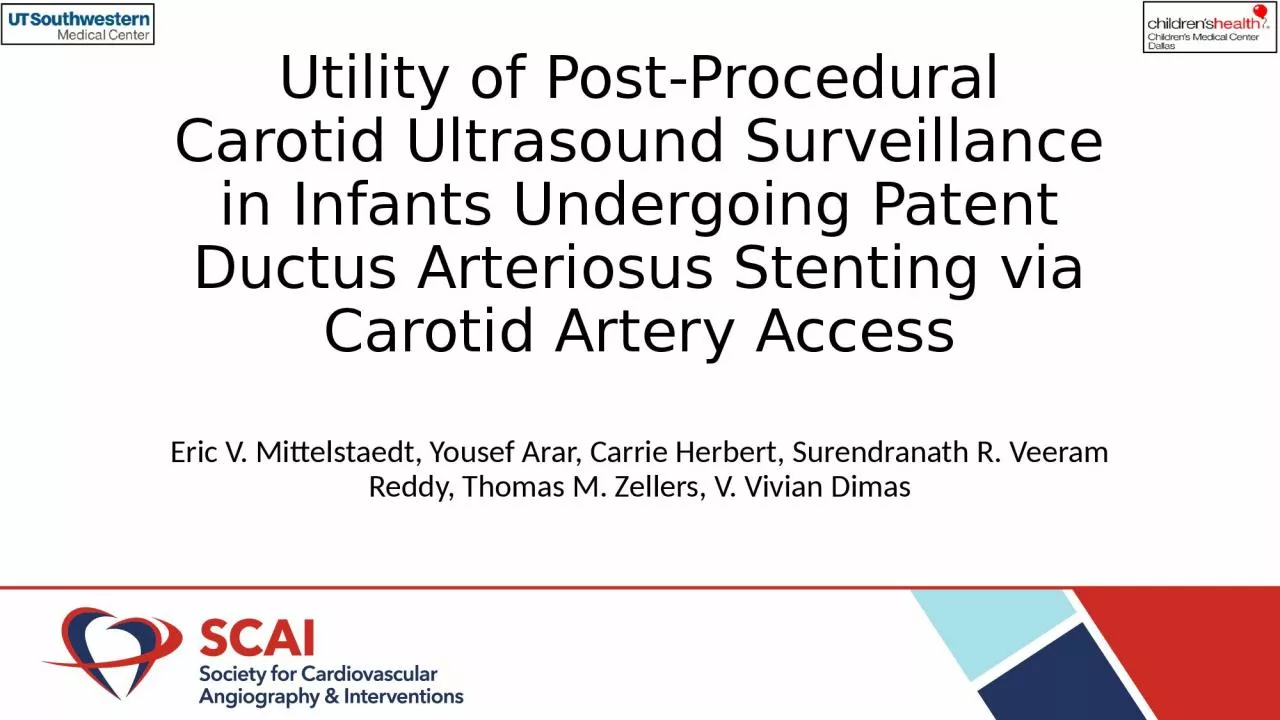

Eric V Mittelstaedt Yousef Arar Carrie Herbert Surendranath R Veeram Reddy Thomas M Zellers V Vivian Dimas Disclosures None Background PDA stenting is increasingly utilized in patients with ductal dependent pulmonary blood flow ID: 930501
Download Presentation The PPT/PDF document "Utility of Post-Procedural Carotid Ultra..." is the property of its rightful owner. Permission is granted to download and print the materials on this web site for personal, non-commercial use only, and to display it on your personal computer provided you do not modify the materials and that you retain all copyright notices contained in the materials. By downloading content from our website, you accept the terms of this agreement.
Slide1
Utility of Post-Procedural Carotid Ultrasound Surveillance in Infants Undergoing Patent Ductus Arteriosus Stenting via Carotid Artery Access
Eric V. Mittelstaedt, Yousef
Arar
, Carrie Herbert,
Surendranath
R.
Veeram
Reddy, Thomas M. Zellers, V. Vivian Dimas
Slide2Disclosures
None
Slide3Background
PDA stenting is increasingly utilized in patients with ductal dependent pulmonary blood flow
Femoral arterial access in neonates limited by:
Size
Angle of approach
ComplicationsAlternative access sites have been used successfully for PDA stentingPercutaneous common carotid artery access has been shown to be a safe alternative
Glatz AC, Et Al. Circulation. 2018; 137:589-601
Kim J, Et Al. Cardiology in the Young. 2017; 27:912-917
Justino H, Petit CJ. Circ Cardiovasc
Interv
. 2016;9:e003003
Slide4Study Goals
To assess the utility of post procedural carotid ultrasound in patients undergoing PDA stenting via common carotid arterial access
Evaluate incidence of common carotid artery injury
Slide5Methods
Retrospective chart review of electronic medical record
Infants undergoing PDA stenting via common carotid artery access
September 2013 through December 2019
Prospective nonrandomized post-procedure carotid u/s performed starting in 2015
Slide6Total PDA Stents
n = 84
Slide7Patient Demographics
Percutaneous (n = 22)
Surgical Cut-Down (n = 11)
Median Age (Days)
6 (Range: 1 – 105)
14 (Range: 4 – 79)
Median Weight (kg)
3.1 (Range: 2.3 – 4.9)
2.6 (Range: 2 – 5.2)
Median Length (cm)
49 (Range: 43 – 56)
46 (Range: 38 – 48)
Male
13 (59%)
6 (54%)
Slide8Procedure Data
Percutaneous (N = 22)
Surgical Cut-Down (N = 11)
Procedure Time (Min)
113 (Range: 44 – 331)
120.5 (Range: 59 – 345)
Time to Sheath Insertion (Min)
11 (Range: 1 – 49)
14.5 (Range: 5 – 23)
Fluoroscopy Time (Min)
18.4 (Range: 10.3 – 118)
16.3 (Range: 7.4 – 156)
Procedure Success
20 (91%)
8 (73%)
Mortality
0 (0%)
0 (0%)
Slide9Post Procedure Carotid Ultrasound
Percutaneous Access
21/22 underwent carotid ultrasound
20 (95%) performed <24 hours post procedure
17 (81%) were normal
Slide10Carotid Ultrasound Status Post Percutaneous Access
Occlusive thrombus
Focal stenosis
Intimal injury
Normal US = 17/21 (81%)
Pseudoaneurysm
Slide11Occlusive Thrombus
Initially managed with heparin infusion and aspirin
Transitioned to enoxaparin
Thrombus became non-occlusive at 6 month follow-up ultrasound
Occlusive thrombus
Slide12Post Procedure Carotid Ultrasound
Surgical Cut-Down
6/11 underwent carotid ultrasound
5 (83%) performed <24 hours post procedure
One patient with focal area of stenosis
Slide13Discussion
Majority of post procedural carotid ultrasounds normal
81% percutaneous group vs. 83% surgical cut-down group
Prior studies showed 84% CCA patency after repair post ECMO
No major post procedural access complications since implementation of ultrasound surveillance
Most abnormal findings managed conservatively
Duggan EM, Et Al. J
Pediatr
Surg. 2015: 50(1): 64-68
Slide14Conclusions
Percutaneous carotid access is a safe alternative to surgical cut-down
Post procedural carotid ultrasound surveillance aids in early identification of access complications and early institution of therapy
Slide15Future Directions
Continued evaluation of post-procedural carotid ultrasound as our number of cases increase
Slide16Thank you